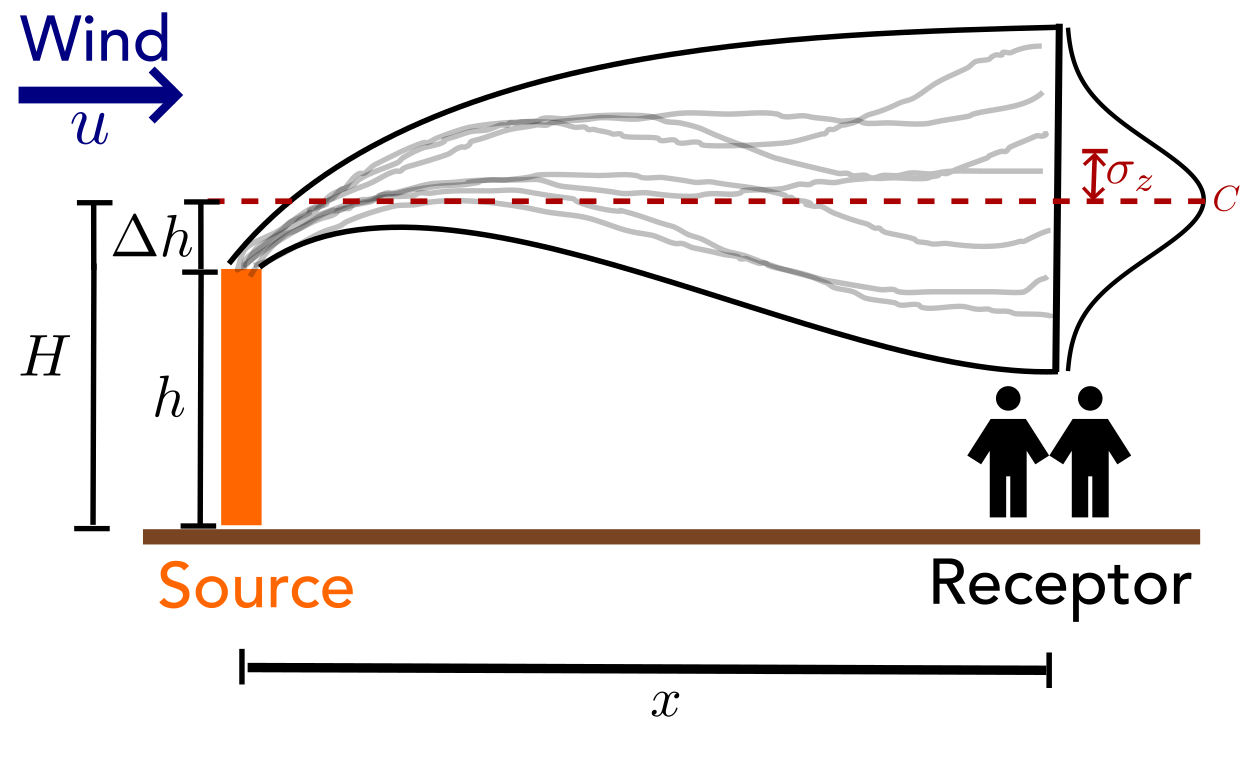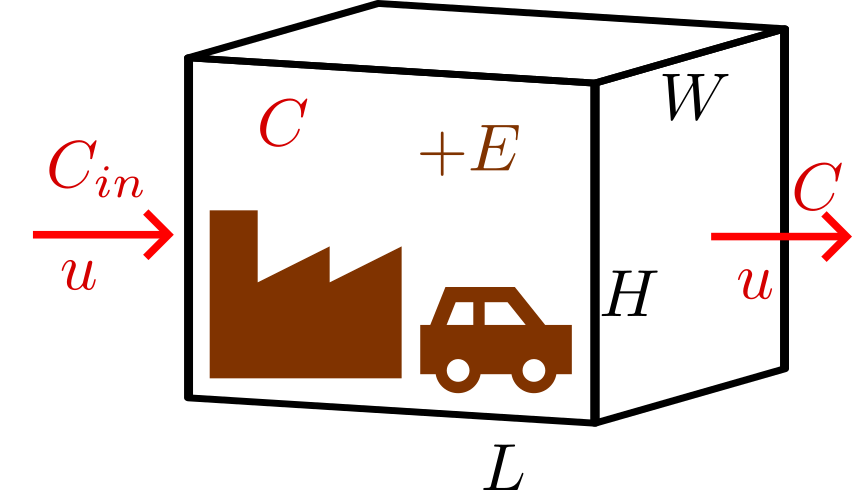class: center, middle .title[Emissions: Multiple Point Sources and Box Models] <br> .subtitle[BEE 4750/5750] <br> .subtitle[Environmental Systems Analysis, Fall 2022] <hr> .author[Vivek Srikrishnan] <br> .date[October 26, 2022] --- name: toc class: left # Outline <hr> 1. Questions? 2. Gaussian Plume Model Recap 3. Multiple Point Sources/Receptors Example 4. Box Models for Airsheds --- name: poll-answer layout: true class: left # Poll <hr> .left-column[{{content}} URL: [https://pollev.com/vsrikrish](https://pollev.com/vsrikrish) Text: **VSRIKRISH** to 22333, then message] .right-column[.center[]] --- name: questions template: poll-answer ***Any questions?*** --- layout: false # Last Class <hr> * Gaussian Plume Model --- class: left # Gaussian Plume Model Recap <hr> .center[] --- class: left # Gaussian Plume Model Recap <hr> $$ \begin{aligned} C(x,y,z) = &\frac{Q}{2\pi u \sigma\_y \sigma\_z} \exp\left(\frac{-y^2}{2\sigma\_y^2} \right) \times \\\\ & \quad \left[\exp\left(\frac{-(z-H)^2}{2\sigma\_z^2}\right) + \exp\left(\frac{-(z+H)^2}{2\sigma\_z^2}\right) \right] \end{aligned} $$ Assumptions: 1. Steady-State, no reactions 2. Constant wind vector, wind >> dispersion in $x$-direction 3. Smooth ground (avoids turbulent eddies and other reflections) --- class: left # Gaussian Plume Model Recap <hr> Dispersion factors $\sigma_y$ and $\sigma_z$ determined by atmospheric stability class: | Class | Stability | Description | |:-----:|:------------------- |:------------------- | | A | Extremely unstable | Sunny summer day | | B | Moderately unstable | Sunny & warm | | C | Slightly unstable | Partly cloudy day | | D | Neutral | Cloudy day or night | | E | Slightly stable | Partly cloudy night | | F | Moderately unstable | Clear night | .center[.cite[Source: https://courses.ecampus.oregonstate.edu/ne581/eleven/]] --- # Multiple Point Sources <hr> .left-column[ Suppose we have three sources of SO$_2$: | Source | Emissions (kg/day) | Effective Height (m) | Removal Cost ($/kg) | |:------:| ------------------:| --------------------:| -------------------:| | 1 | 34,560 | 50 | 0.20 | | 2 | 172,800 | 200 | 0.45 | | 3 | 103,680 | 30 | 0.60 | and five receptors at ground level with $u = 1.5$ m/s, air quality standard 150 $\mu\text{g/m}^3$. ] .right-column[.center[]] --- # Modeling Considerations <hr> .left-column[ Would like to know relationship between source emissions ($Q_i$ and receptor exposure) Receptors are only affected by upwind sources. ] .right-column[.center[]] --- # How to Combine Concentrations From Multiple Sources? <hr> -- Additive: $$ \begin{aligned} \text{Concentration} &= \frac{M_1 + M_2 + M_3}{V} \\\\ &= \frac{M_1}{V} + \frac{M_2}{V} + \frac{M_3}{V} \\\\ &= C_1 + C_2 + C_3 \end{aligned} $$ --- # Developing Constraints <hr> Want to model exposure as a function of the emissions $Q_i$. How? -- Write $C_i(x,y) = Q_it_i(x,y)$, where the $t_i$ is the transmission factor $$ t_i(x,y) = \frac{1}{2\pi u \sigma\_y \sigma\_z} \exp\left(\frac{-y^2}{2\sigma\_y^2} + \frac{H^2}{\sigma\_z^2}\right) $$ -- This turns exposure constraints linear as a function of $Q_i$: for a receptor $j$ (with fixed location $(x_j, y_j)$), $$ \text{Exp}\_j = \sum\_i Q\_i t\_i(x\_j, y\_j) \leq 150\ \mu\text{g/m}^3 $$ --- # Dispersion Spread <hr> **Last class**: Tables for $\sigma_y$ and $\sigma_z$ fits based on atmospheric stability class. $$ \begin{aligned} \sigma_y &= ax^{0.894} \\\\ \sigma_z &= cx^d + f \end{aligned} $$ .center[ .cite[Source: [https://courses.washington.edu/cee490/DISPCOEF4WP.htm](https://courses.washington.edu/cee490/DISPCOEF4WP.htm)] ] --- # Calculating Transmission Factors <hr> Let's assume we're in stability class C. Then we have $\sigma_y = 104x^{0.894}$ and $\sigma_z = 61x^{0.911}$ (regardless of distance). .center[ .cite[Source: [https://courses.washington.edu/cee490/DISPCOEF4WP.htm](https://courses.washington.edu/cee490/DISPCOEF4WP.htm)] ] --- # Calculating Transmission Factors <hr> Now we can write a function: ```julia # delta_x, delta_y should be in m # should subtract receptor from source for upwind check function transmission_factor(delta_x, delta_y, u, H) if delta_x <= 0 tf = 0. else sigma_y = 104 * (delta_x / 1000)^0.894 sigma_z = 61 * (delta_x / 1000)^0.911 tf_coef = 1/(2 * pi * u * sigma_y * sigma_z) tf = tf_coef * exp((-0.5 * (delta_y / sigma_y)^2) + (H / sigma_z)^2) end return tf end ``` --- # Calculating Transmission Factors <hr> .left-column[ For example, from Source 1 to Receptor 1: ```julia transmission_factor(1000, 5500, 1.5, 50) ``` ``` 0.0 ``` Source 1 to Receptor 2: ```julia transmission_factor(3000, 0, 1.5, 50) ``` ``` 2.521069616495523e-6 ``` ] .right-column[.center[]] --- # Calculating Transmission Factors <hr> ```julia sources = [(0, 7), (2, 5), (3, 5)] receptors = [(1, 1.5), (3, 7), (5, 3), (7.5, 6), (10, 5)] H = [50, 200, 30] calctf(i, j) = transmission_factor( 1000 * (receptors[j][1] - sources[i][1]), 1000 * (receptors[j][2] - sources[i][2]), 1.5, H[i]) tf = [calctf(i, j) for i in 1:length(sources), j in 1:length(receptors)] ``` --- # Calculating Transmission Factors <hr> ```julia using DataFrames DataFrame(tf, string.(collect(1:length(receptors)))) ``` <div><div style = "float: left;"><span>3×5 DataFrame</span></div><div style = "clear: both;"></div></div><div class = "data-frame" style = "overflow-x: scroll;"><table class = "data-frame" style = "margin-bottom: 6px;"><thead><tr class = "header"><th class = "rowNumber" style = "font-weight: bold; text-align: right;">Row</th><th style = "text-align: left;">1</th><th style = "text-align: left;">2</th><th style = "text-align: left;">3</th><th style = "text-align: left;">4</th><th style = "text-align: left;">5</th></tr><tr class = "subheader headerLastRow"><th class = "rowNumber" style = "font-weight: bold; text-align: right;"></th><th title = "Float64" style = "text-align: left;">Float64</th><th title = "Float64" style = "text-align: left;">Float64</th><th title = "Float64" style = "text-align: left;">Float64</th><th title = "Float64" style = "text-align: left;">Float64</th><th title = "Float64" style = "text-align: left;">Float64</th></tr></thead><tbody><tr><td class = "rowNumber" style = "font-weight: bold; text-align: right;">1</td><td style = "text-align: right;">0.0</td><td style = "text-align: right;">2.52107e-6</td><td style = "text-align: right;">8.00714e-25</td><td style = "text-align: right;">1.27113e-7</td><td style = "text-align: right;">1.30119e-8</td></tr><tr><td class = "rowNumber" style = "font-weight: bold; text-align: right;">2</td><td style = "text-align: right;">0.0</td><td style = "text-align: right;">3.85489e-81</td><td style = "text-align: right;">5.36921e-17</td><td style = "text-align: right;">1.39136e-7</td><td style = "text-align: right;">4.99931e-7</td></tr><tr><td class = "rowNumber" style = "font-weight: bold; text-align: right;">3</td><td style = "text-align: right;">0.0</td><td style = "text-align: right;">0.0</td><td style = "text-align: right;">2.85279e-29</td><td style = "text-align: right;">4.86765e-8</td><td style = "text-align: right;">5.02337e-7</td></tr></tbody></table></div> --- # Optimization Formulation: Decision Variables <hr> What are our decision variables? -- Let's use: $R_i$, fraction of emissions reduced at source $i$. Then $Q_i = (1-R_i)E_i$, where $E_i$ is the emissions corrected to the appropriate units). ```julia using JuMP using HiGHS air_model = Model(HiGHS.Optimizer) @variable(air_model, 0 <= R[1:3] <= 1) ``` --- # Optimization Objective <hr> | Source | Emissions (kg/day) | Emissions (g/s) | Effective Height (m) | Removal Cost ($/kg) | |:------:| ------------------:| ---------------:| --------------------:| -------------------:| | 1 | 34,560 | 400 | 50 | 0.20 | | 2 | 172,800 | 2000 | 200 | 0.45 | | 3 | 103,680 | 1200 | 30 | 0.60 | -- $$ \begin{aligned} \min\_{R\_i} Z &= \sum_i RemCost_i \times DayEmis_i \times R_i \\\\ &= (0.20) (34560) R_1 + (0.45)(172800) R_2 + (0.60)(103680) R_3 \\\\ &= 6912R_1 + 77760R_2 + 62208R_3 \end{aligned} $$ ```julia @objective(air_model, Min, 6912*R[1] + 77760*R[2] + 62208*R[3]) ``` --- # Optimization Constraints <hr> * Exposure Constraints: $$ \begin{aligned} \text{Exp}\_j = \sum\_i Q\_i t\_i(x\_j, y\_j) &\leq 150\ \mu\text{g/m}^3 \\\\ \Rightarrow \sum\_i E\_it\_{ij}(1-R\_i) &\leq 150 \times 10^{-6} \end{aligned} $$ ```julia E = [400, 2000, 1200] @constraint(air_model, exposure[j in 1:5], sum([E[i] * tf[i, j] * (1-R[i]) for i in 1:3]) <= .00015) ``` --- # Optimization Constraints <hr> * Bounds: $$ \begin{aligned} R_i &\leq 1 \\\\ R_i &\geq 0 \end{aligned} $$ --- # Let's Optimize! <hr> ```julia set_silent(air_model) optimize!(air_model) objective_value(air_model) ``` ``` 130452.09910765485 ``` ```julia value.(R) ``` ``` 3-element Vector{Float64}: 0.8512536117422739 1.0 0.7524471795153719 ``` -- **Does this make sense?** --- # Untreated Exposure <hr> ```julia (E .* tf) .* 1e6 # in micrograms/m^3 ``` ``` 3×5 Matrix{Float64}: 0.0 1008.43 3.20285e-16 50.8453 5.20476 0.0 7.70977e-72 1.07384e-7 278.272 999.863 0.0 0.0 3.42335e-20 58.4117 602.804 ``` --- # Reduced Exposure <hr> ```julia (E .* (1 .- value.(R)) .* tf) .* 1e6 ``` ``` 3×5 Matrix{Float64}: 0.0 150.0 4.76413e-17 7.56306 0.774189 0.0 0.0 0.0 0.0 0.0 0.0 0.0 8.47459e-21 14.46 149.226 ``` --- # Why This Plan Makes Sense <hr> Basically (ignoring source 1, which is constrained by receptor 2): We *could* reduce emissions from source 2 by ~85% to comply at receptor 5, but then would also need to reduce source 3's emissions by 100%, at a cost of **~128,304**. This plan involves eliminating all of source 2's emissions, but only 75% of source 3's, at a cost of **124,416**. --- # What If Removal Isn't 100% Effective? <hr> ```julia set_upper_bound.(R, [0.95, 0.95, 0.95]) optimize!(air_model) objective_value(air_model) ``` ``` 131723.27709752615 ``` ```julia value.(R) ``` ``` 3-element Vector{Float64}: 0.8512536117422739 0.95 0.8353814964821816 ``` --- # Gaussian Plume Upshot <hr> .left-column[ Remember the key assumptions: * Steady-state, no reactions * Constant wind * Wind >> dispersion in $x$-direction * Smooth ground ] .right-column[] --- # Airsheds and Box Models <hr> .left-column[ **Box models** are all about mass-balance. Denote by $C$ (g/m$^3$) the concentration in box, $E$ (g/s) the emissions rate within the box;, $u$ (m/s) the wind speed, and by $L, W, H$ the box dimensions (m) ] .right-column[] --- # Steady-State Box Model <hr> .left-column[ First, consider a steady-state box, $\Delta m = 0$. $$ \begin{aligned} 0 &= \dot{m}\_{in} - \dot{m}\_{out} + E \\\\ &= u WH C\_{in} - u WH C + E \\\\ C &= C\_{in} + \frac{E}{uWH} \end{aligned} $$ ] .right-column[] --- # Quick Example <hr> A box surrounding a city has dimensions $W = 4km$, $L = 8km$, $H=1km$. The upwind concentration of $CO$ is 5 $\mu\text{g/m}^3$ and the wind is moving at 2 m/s. The emission rate of $CO$ within the city is $3 \mu\text{g/(s} \cdot \text{m}^2)$. What is the concentration of $CO$ over the city? -- $$ E = (3 \mu\text{g/(s} \cdot \text{m}^2))(8000 \text{m})(4000 \text{m}) = 9.6 \text{g/s} $$ -- $$ C = (5 \mu\text{g/s}) + \frac{9.6 \text{g/s}}{(2 \text{m/s})(4000 \text{m})(1000 \text{m})} = 6.2 \mu\text{g/s} $$ --- # Emissions Credits and Trading <hr> When using a "box" representation, all that matters is the total emissions not exceeding a certain level within the box. Opens the door for emissions credits/trading as a market-based mechanism vs. a pure regulation. -- **What are some pros and cons of these approaches?** --- # Sources and Sinks <hr> Of course, we could also have sinks (including reactions) which absorb or consume some of the contaminant. How would this change our simple box model? -- Modify $E$ as net emissions, sources - sinks (might have to model these processes more explicitly, which adds complexity). --- # Multi-Box Models <hr> Box models get more interesting when multiple boxes are combined (think your dissolved oxygen example from the simulation unit). This allows for 2d or 3d fate & transport modeling with potentially heterogeneous advection, mixing, and source/sink rates. But can be computationally expensive over large regions: need to loop and evaluate over many boxes. --- # Key Takeaways <hr> * Gaussian Plume: all upwind sources can affect downwind receptors. * Assumptions may not generally hold –- how much does this matter? * Box models allow for more flexibility when more detailed mass-balance is required, but are computationally more expensive to combine over large domains. --- class: middle, center <hr> # Next Class <hr> * Dissolved Oxygen revisited * Simulation-Optimization methods